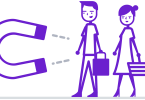Ten thousand small businesses use AutoPilot, the Fivestars automated messaging feature included in our customer loyalty program. It sends targeted promotions, deals, and rewards to your Fivestars members based on their visit behavior (as explained below). When implemented well, these automated rewards or deals, which you as a business owner create, manage, and activate, drive significant business back through the door, and more often.
In fact, in 2015, AutoPilot drove 3.1 million repeat visits back to small businesses that may not have happened otherwise. And, AutoPilot alone “won back” 1.3 million “lost” customers (those who dropped off and hadn’t visited in quite some time) – Wow!
To ensure your business also garners stellar repeat business, this guide will walk you through the three key aspects of setting up AutoPilot successfully:
Create Enticing Rewards for the 7 Illustrious AutoPilot Campaigns
AutoPilot includes seven different campaigns, which are based off customer behavior. Businesses who see the most success with Fivestars activate and implement enticing rewards for seven of the following campaigns below
1. Network
This campaign reaches out to customers who found your business via the Fivestars mobile app or online, and indicated interest by adding you to their “memberships” section. When you activate this campaign, AutoPilot sends these members (and potential new customers) a message/offer a week after they’ve added your business to their “memberships.”
Best offer/reward: Send this audience an attention-grabbing offer like a free appetizer with purchase, or a buy one, get one free deal, as they’re not yet familiar with your business and need a little more encouragement to come in than say, a regular customer who already knows you.
2. Lost
The Lost campaign reaches out to customers who haven’t been back in 180, 270, or 365 days via email or mobile app notification only.
Best offer/reward: If a customer hasn’t visited in over five months, chances are they won’t visit again. Make sure to offer a big discount like 50% off an item.
3. First Visit
The First Visit campaign is sent 24 hours after new member joins your loyalty program, after they’ve visited. If the new member is also a new customer, this offer has the potential to drive a second visit sooner rather than later – This is especially important because 60% of new customers never visit a business again.
If the new member is already an established customer, this offer will demonstrate and reiterate the advantages of joining the loyalty program in the first place.
Best offer/reward : A smaller promotion will work here, like a free soft drink with purchase or 10% off their next visit.
4. Growth
This offer is sent either every 3rd, 5th, or 10th visit and is intended to thank your loyal customers for visiting frequently.
Best offer: Since these customers are benefitting from your rewards program, a smaller reward works here as well.
5. At-Risk
This reward targets your lost customers who have not visited your business in 15, 30, or 45 days.
Best offer/reward: This offer should be really enticing to help drive business back and keep you top-of-mind. A buy one, get one free offer is a great idea here, as they’ll also likely bring in a friend.
6. Lapsed
This reward/offer is sent to customer who hasn’t visited your business in 30, 45, 60, 90, 120, or 150 days.
Best offer/reward: This offer is meant to capture customers who didn’t respond to the “At-Risk” offer, so we suggest making this offer more aggressive (think 40% off, free appetizer, etc.) because you want to re-capture the customer’s attention.
7. Birthday
This reward is sent to members who have a birthday coming up in 7 days, 14 days, or 30 days. It’s a nice way to say “happy birthday!” to your customers and make them feel valued.
Best offer/reward: This offer can be anything, so be creative!
Set Semi-Urgent Expirations
You need to set up expiration dates for each AutoPilot offer – This gives members a sense of urgency to redeem the reward and visit your business sooner than later. The best way to do that with AutoPilot is by setting your expiration dates to be no longer than 14 days. We often find 7 days or 14 days to be the most effective.
If the expiration date is too soon (say 1 or 2 days out), members may not have enough time to redeem the reward. When tracking your results, if your “claims” are high, but your “redemptions” are low, this will indicate that members liked the offer, but simply didn’t have enough time to visit your business.
Here’s an example of an effective AutoPilot program with enticing rewards and semi-urgent expiration dates in place:
Restaurant/Bar
Network
Free appetizer
Exp. in 7 days
First Visit
50 cent well or draft
Exp. in 14 days
Growth (every 5th visit)
Buy 1 appetizer, get 1 50% off
Exp. in 14 days
At-Risk (hasn’t visited in 30 days)
$5 off your next bill of $25
Exp. in 7 days
Lapsed (hasn’t visited in 60 days)
15% off total bill
Exp. in 7 days
Lost (hasn’t visited in 150 days)
25% off total bill
Exp. in 7 days
Birthday (sent 7 days prior)
Free dessert
Exp. in 7 days
Consistently Track Your Results with Improved Reporting
Once your AutoPilot campaigns have been up and running for at least a month, you’ll start to see your results found in your Dashboard. With our improved AutoPilot reporting, you can easily track your campaign success and fine-tune each campaign to be more effective.
The primary metrics you can track are Claims, Redemptions and Opt-Outs. There’s a ton you can dig into with these metrics. For more details about what each metric means check out this blog post on Promotions reporting. It has excellent information relevant for AutoPilot, too!
If you’re not seeing quite the return you wanted with your AutoPilot campaigns, try tweaking it. Often, the best way to find out what’s right for your business is by testing out different offers to see what sticks.
Have questions? Let us know in the comments below!






Leave a Comment